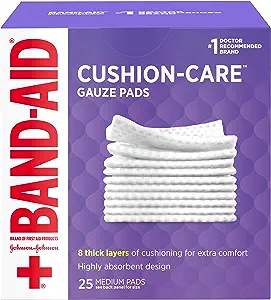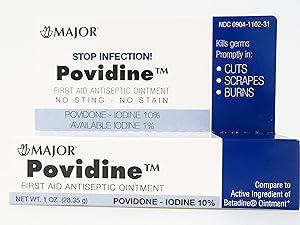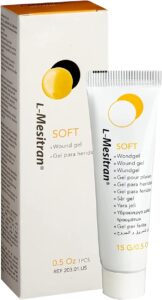Can you treat a wound on your cat's back yourself?
Your cat has a wound on its belly, then obviously your cat was obviously was in an accident. He was in a fight or collided with a vehicle. As long as your cat doesn’t have a major wound, you can treat it yourself. The wound edges should not be far apart when the skin is completely cut through. And the wound should not be larger than half a centimeter. It may be larger for superficial abrasions. Are you in doubt? Call your veterinarian. If the wounds are very large or there seems to be more damage than just the skin, it is wiser to take your cat to your vet.
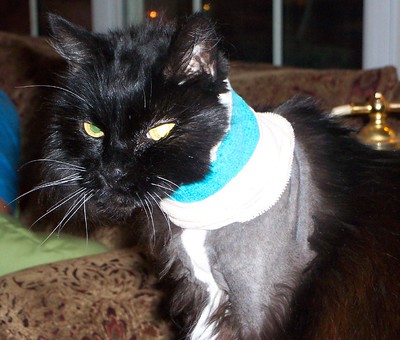
How do you treat a wound on your cat's back?
CALM DOWN
It is of course very shocking when you see that your cat has a wound on its back. Some people react very panicked to it. Cats get very stressed by this. And they already had a good portion of stress from the reason why they got a wound on their back. So first make sure you calm yourself down. If you are calm, your cat will let you assess his wound on his back better. Even if it bleeds, you can take 5 minutes to relax. Unless, of course, large puddles come out at the same time. But with a little blood, the wound is also cleaned. So take a moment to relax and only then approach your cat to view the wound on its back.
Cleaning the wound
You do this by wetting a gauze compress with boiled cooled down clean water and cleaning the wound with it. If you live in a country with less good quality water, you can also use bottled still water. If you have a long-haired cat, see if it is necessary to trim the surrounding hairs a little short so that they do not stick to the wound, causing a wound infection.
Disinfect the wound
After cleaning the wound on your cat’s back, you need to disinfect the wound. When disinfecting, we ensure that the bacteria, viruses and other organisms that entered the wound get killed. This reduces the chance of a wound infection many times. Disinfection is best done with iodine ointment. You rub this on the wound on your cat’s back. You can also use iodine solution, but it is a bit more difficult to use on a back of a cat. However, the effectiveness of both the ointment and the solution is equivalent. Make sure not to put too much on the wound. It only needs to be slightly ocher coloured.
Stimulate wound healing
After cleaning and disinfecting the wound on your cat’s back you want to stimulate the healing of the wound. This means that you treat the wound in such a way that bacteria have no chance to grow. An infection therefore stays away. And you also ensure that the recovery tissue is produced as quickly as possible. Depending on how deep the wound is, part of this tissue will be normal skin that will grow back from the wound edges. And part of it will be granulation tissue, which you better know as scar tissue. The faster the wound closes, the less it will bother your cat and the less chance of complications there is. A good way to stimulate wound healing is honey ointment. It is best to apply this remedy to the wound 3 times a day for 5-7 days.
How do you protect the wound on your cat's back while it heals?
In principle, you do not need to protect a wound on your cat’s back while it is healing. Allowing to air to dry the wound between ointment applications is best. But some cats scratch or lick their wounds. They do this when they experience itching or pain from the wound on their back. In this case it is best to put a medical pet shirt on.
Is it bad if my cat licks his wound?
In principle, a little licking won’t do much harm. With this he keeps his wound clean and his saliva also contains healing substances. But unfortunately it turns out that many cats don’t stop at a little bit of licking on the wound. If he licks it a lot, he will easily lick away newly formed tissue, which is still very fragile. That way the wound cannot heal. He also licks the healthy surrounding skin, resulting in aggravation of the wound. So just put on a medical pet shirt for safety.
How can you tell if a wound is inflamed?
A wound in which an infection occurred does not form a nice dry crust. The wound remains wet and possibly even suppurative for days after it developed. If a crust has formed on it, you can easily remove that crust because a layer of pus will accumulate between the wound and the crust. If the wound looks dry after 24 hours and you cannot easily peel off the formed scab, then the wound heals well.
The wound on my cat's back smells bad.
A smelly wound is almost always infected with bacteria. These bacteria produce bad substances that smell. So if there is a smelly wound, you will have to treat the wound extra (see below) or take your cat to your vet.
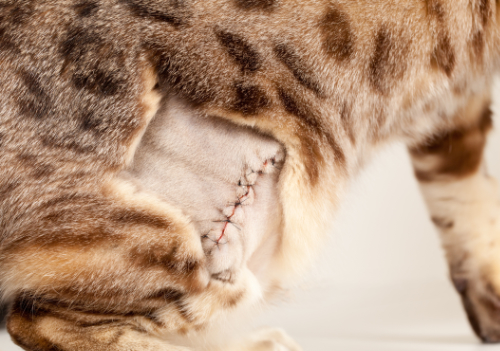
Treating an inflamed infected wound on your cat's back
When the wound is infected, antibacterial treatment is required. An antibiotic cure is the most powerful for this. But you can also continue to apply some iodine ointment to the wound twice a day for 5 days. Iodine slows down wound healing quite a bit, but because you prevent bacterial growth, the wound heals better than if you don’t use it. However, if an abscess occurs, i.e. an infection lying deeper under the skin, then iodine isn’t effective enough. In that case your cat needs antibiotics.
What if the wound doesn't heal properly?
In that case, there is probably still an object in the wound on his back or a bacterial wound infection has occurred that you didn’t stop with the iodine. Cats regularly suffer from abscesses as a result of fights. As a result, the wound cannot heal properly and may even fester. In this case, you should take your cat to your vet. He can see if it is necessary to clean the wound on your cat’s back under anesthesia. But in most cases, a course of antibiotics is sufficient.
Good luck
We hope the advice we have written down for you will help you and your cat. Good luck for the both of you in healing that nasty wound.

